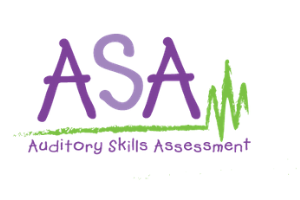Author:
Donna Geffner, PhD, Ronald Goldman, PhD
Overview:
Screen children as young as 3:6 for early auditory and phonological skills—and get fast results to put children on the right track
Age Range:
3:6—6:11
Administration:
Paper-and-pencil/CD-ROM
Scoring Option:
Manual scoring
RTI Tiers:
RTI Level 1
Completion Time:
Completion Time: About 5 minutes (ages 3:6— 4:11); About 15 minutes (ages 5:0—6:11)
Scores/Interpretation:
Overall cut scores
Publication Date:
2010
The ASA provides you with a tool for early identification of young children who might be at risk for auditory skill deficits and/or early literacy skill difficulties. Developed by Dr. Donna Geffner and Dr. Ronald Goldman, this screener provides accurate, developmentally based results to help you determine which children may need follow-up, intervention, or further evaluation.
Users & Applications
The ASA is designed for varied uses, including the following:
“Lots of good information. I was always of the camp that we should wait until those brain functions are better developed before we assess, but you have me convinced that we can start younger–just using age appropriate measures and materials. Thanks!”
—Heather Meadows, MS, CCC-SLP
Geneva, IL
- Early identification and intervention.
A child identified on the ASA as at risk for auditory skill-related deficits may be a good candidate for an in-depth evaluation and/or possible early intervention.
- Universal screening.
The ASA can be used to screen children ages 3:6–6 :11 as a preliminary assessment of their auditory skills. It is a perfect companion to routine hearing screenings within the given age range.
- Progress monitoring.
Re-administration of the ASA can be used to check a child’s progress with auditory skills and to determine if an intervention is working, still required, or if an in-depth assessment of the child’s skills is needed.
Features & Benefits
The ASA is designed to be a quick, reliable indicator of a young child’s auditory skills and includes the following features:
- Unscored practice items provide opportunity to teach the tasks
- Individual, untimed administration and scoring procedures that are quick, easy, and objective
- No required reading or written responses
- Large, full-color illustrations tested to appeal to young children
- An indicator of performance (high, average, low) by domain to pinpoint further assessment or intervention needs
- Case studies highlighted in the manual for supported use of the ASA
- Researched validity and reliability
The ASA offers the following benefits:
- Assesses auditory skills critical to the development of oral and written language skills
- Offers the youngest age range in a published auditory skills screening and can provide an early warning indicator
- Reflects best practices in behaviorally based auditory screening
- Serves as a low tech, friendly screener for young children, that doesn’t require headphones or an audiometer (a Stimulus CD is used to present stimuli)
- Helps point you in the right direction by providing an indicator of performance across each domain on the ASA, which may indicate a need for further follow-up evaluation, immediate intervention/instruction in auditory skills, or re-screening
Content & Administration

Psychometric Information
From December 2008 through May 2009, over 600 children were tested at 123 locations throughout the United States to define cut scores that would best discriminate clinical cases from non-clinical cases and to study the final screener’s reliability, validity, and clinical utility. ASA research included:
- Qualitative reviews and empirical analyses to maximize fairness for individuals from different groups (by sex, race/ethnicity, socioeconomic status, and geographic region)
- A standardization sample of children ages 3:6–6:11 whose primary language (most frequently spoken language) was English, who had normal vision with or without corrective aids, and were free of upper respiratory problems or ear infections at the time of testing
- The requirement that all children in the standardization and clinical samples could pass a pure tone hearing screening at 20 db HL at 1000, 2000, and 4000 Hz in both ears within one week prior to ASA testing, to ensure hearing acuity of the participants
- A standardization sample that accurately reflects the U.S. population according to important demographic variables
-
ASA Intro: An Introduction to the new Auditory Skills Assessment
This pre-recorded 20-30 minute session allows you to learn at your leisure. All you need is access to the Internet and the sound enabled on your computer. Please keep in mind that the session may take a few minutes to load.
This introductory session will take less than 15 minutes to review. At the conclusion, you will learn what the ASA is, why you might want to use it with children 3-6 to 6-11, when it will be released, and how to obtain additional information on the ASA or any other Pearson speech measure.
Attend a session
Pre-recorded Webinars
-
Central Auditory Processing: What Age Should We Test?
Presenter: Donna Geffner, PhD, CCC-SLP/A
There is controversy over the age at which a CAPD can be diagnosed in children. The notion that one has to wait until age 7 or 8 is unfounded. Evidence is strong that CAPD can be identified earlier than age 7 for the purposes of treatment and management. This webinar will provide a rationale for early testing and the instruments available to identify youngsters at risk. Case studies will be presented that show that early identification leads to effective intervention and better academic outcomes.
Date: May 10, 2017
 PDF: Central Auditory Processing: What Age Should We Test?
PDF: Central Auditory Processing: What Age Should We Test?
 Video: Central Auditory Processing: What Age Should We Test?
Video: Central Auditory Processing: What Age Should We Test?
-
AD/HD, (C)APD, or Listening Comprehension Featuring the ASA
Presenter: Donna Geffner, Ph.D.
-
How Young Can You Test (C)APD? The Auditory Skills Assessment (ASA)
Presenter: Donna Geffner
Our webinars can help you better use assessments and interventions to meet the needs of your clients and students.
Date: May 14, 2013


Frequently Asked Questions for Auditory Skills Assessment
Questions and responses follow. Responses are from the test’s author.
- Regarding auditory processing disorders (APD), which discipline should diagnose? In schools, they usually have the psychologist or audiologist make the CAPD diagnosis, even though we have tests as well.
- Could you use the ASA with students who are English Language Learners (ELLs)—especially Spanish-speaking?
- If a child was never taught or exposed to phonological awareness tasks, is it ok to test anyway? Are these skills naturally there or do they have to be taught?
- If I work for a school district, how would the ASA fit—can it be considered a test that would help classify a child?
- How do you score Mimicry with a student who has very poor articulation?
- Can an SLP treat a student for phonological tasks rather than the reading teacher?
- How much “noise” is needed for the testing in noise. Would it be done in the back of a classroom or in a hallway?
- How can I get the school district to use this test for every child enrolled in preschool for the 3 year old and older population?
- It sounds like many parts of this test can be used with older students to obtain clinical information—is that true?
- Can you administer the ASA to a child who has a known speech and language delay?
- In order to score the ASA does the subject need to complete all subtests?
- What is a figure-ground listening skill deficit?
- Could the ASA be an appropriate test for a child with cochlear implants?









